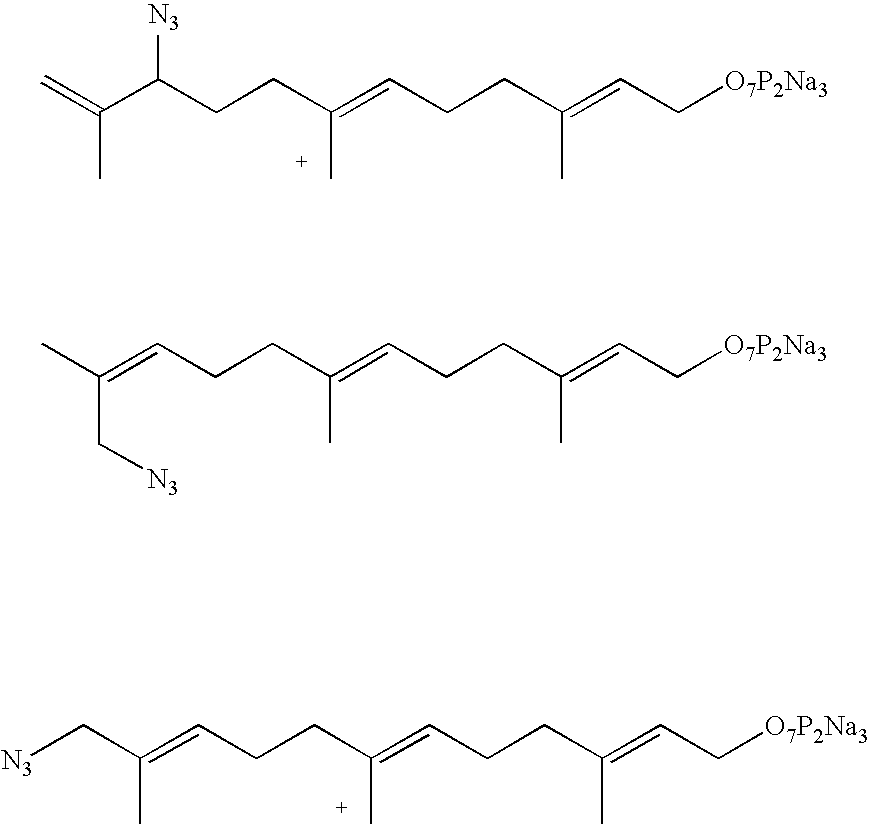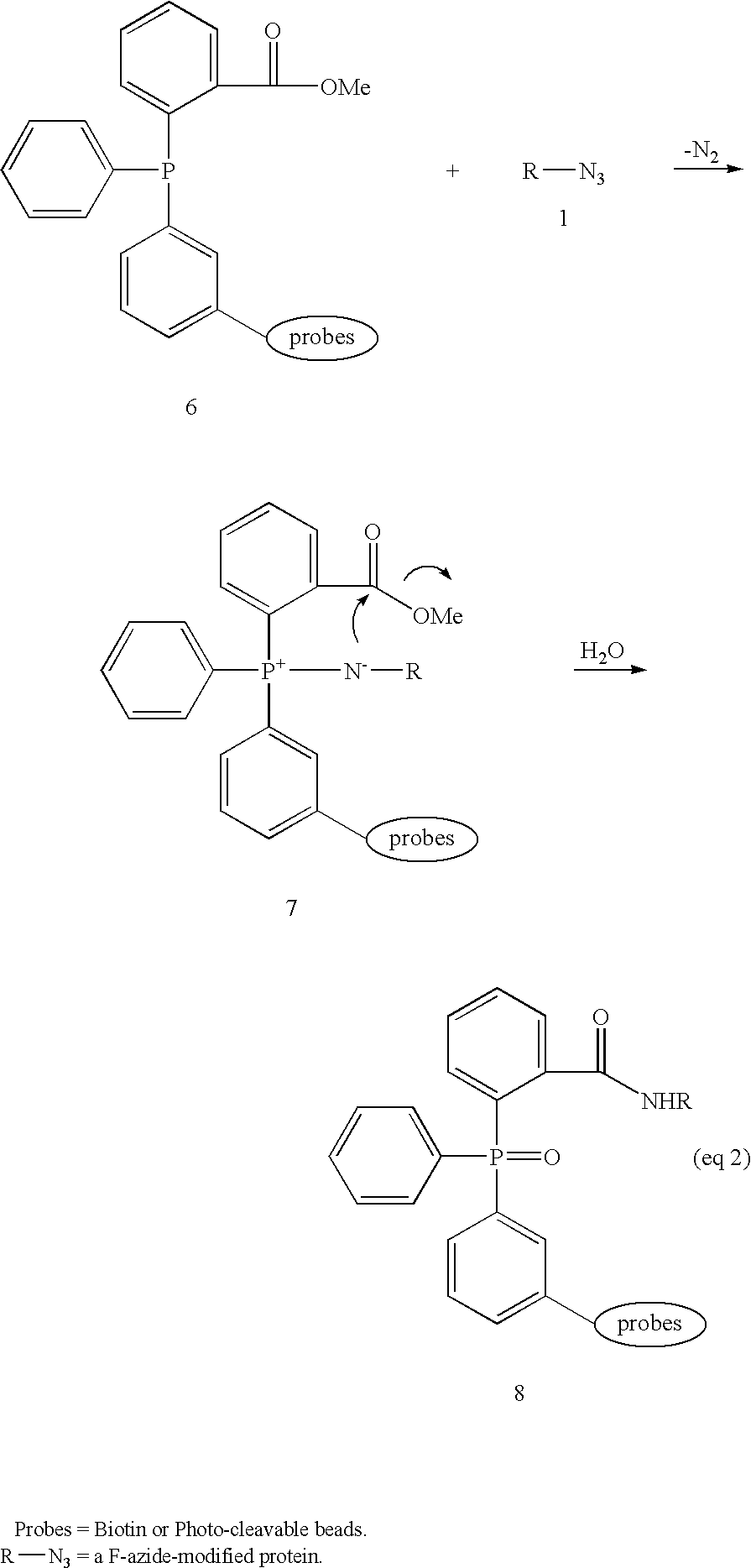Methods and compositions for tagging via azido substrates
a technology of azido substrates and substrates, applied in the field of biochemistry, can solve the problems of not being widely used, not being able to adequately enrich farnesylated proteins from and not being able to achieve the effect of enriching farnesylated proteins in a complex protein mixtur
- Summary
- Abstract
- Description
- Claims
- Application Information
AI Technical Summary
Benefits of technology
Problems solved by technology
Method used
Image
Examples
example 1
Azide-containing Proteins can be Chemoselectively Conjugated by Arylphosphine Capture Reagents by the Staudinger Reaction
[0035]The reduction of organic azides to amines using phosphorus(III) compounds was first described in 1919 and is now widely known as the Staudinger reaction (Gololobov, 1992). Typically, aryl-substituted phosphorus reagents, e.g., triphenylphosphine, are used because of their chemical stability, as alkylphosphines are pyrophoric and decompose violently in contact with water. Reaction of azide 1 with P(III)-reagent 2, usually at room temperature, proceeds with loss of nitrogen and initially generates adduct 3 that can be depicted as an iminophosphorane or an aza-ylide. Subsequent hydrolysis of 3 affords amine 4 and phosphine oxide 5.
[0036]Arylphosphines are comparatively inert towards most enzymatic processes (Kiick. 2002). Their utility as “selectively addressable” in vivo labeling agents has been demonstrated in a series of experiments in which biochemical prob...
example 2
FPP-azide is a Substrate for Protein Farnesylation In Vitro
[0038]To determine whether farnsyltransferase can use FPP azide as a substrate for protein farnesylation, an in-vitro enzymatic reaction was carried out between a CAAX-box containing peptide (RC peptide, KKFFCAIS) and FPP azide. The peptide was shown to be farnesylated in vitro (Yokoyama, 1991).
[0039]The molecular masses of the peptide prior to and after enzymatic reaction were determined by MALDI-TOF mass spectrometry. F-azide-modified peptide was detected after enzymatic reaction (m / z, 1191 Da, a mass increase of 246 Da over RC peptide) (FIG. 2).
[0040]In a parallel study, an enzymatic reaction was carried out with FPP, the natural substrate for protein farnesylation. It was found that the reaction rate between the RC peptide and FPP azide 16 was somewhat faster than that between the RC peptide and FPP. These studies indicate that FPP azide 16 is a good substrate for the farnesyltransfer reaction in vitro.
example 3
Ras and HDJ-2 can be Farnesylated by Exogenous Azido-farnesyl Substrates in vivo
[0041]To determine if the cell will process exogenous azido-farnesyl substrates, metabolic labeling of cells was carried out with synthetic substrates, either FPP azide or F-azide-OH, and mobility-shift assays were performed for Ras and HDJ-2 in order to determine if they are posttranslationally modified. Unprocessed Ras and HDJ-2 move more slowly than their farnesylated isoforms, therefore allowing separation in SDS-PAGE and subsequent detection by Western blotting analysis (James, 1994; Adjei, 2000).
[0042]Lovastatin, a HMG CoA reductase inhibitor, blocks mevalonate synthesis, and therefore leads to inhibition of FPP synthesis and protein farnesylation (Sinensky, 1990; Kim, 1990). As expected, lovastatin was found to induce mobility shift of both Ras and HDJ-2 to higher MW regions, suggesting inhibition of endogenous farnesylation. Metabolic labeling of the cells with either FPP azide or F-azide-OH, how...
PUM
| Property | Measurement | Unit |
|---|---|---|
| mass | aaaaa | aaaaa |
| mass | aaaaa | aaaaa |
| pH | aaaaa | aaaaa |
Abstract
Description
Claims
Application Information
 Login to View More
Login to View More - R&D
- Intellectual Property
- Life Sciences
- Materials
- Tech Scout
- Unparalleled Data Quality
- Higher Quality Content
- 60% Fewer Hallucinations
Browse by: Latest US Patents, China's latest patents, Technical Efficacy Thesaurus, Application Domain, Technology Topic, Popular Technical Reports.
© 2025 PatSnap. All rights reserved.Legal|Privacy policy|Modern Slavery Act Transparency Statement|Sitemap|About US| Contact US: help@patsnap.com



